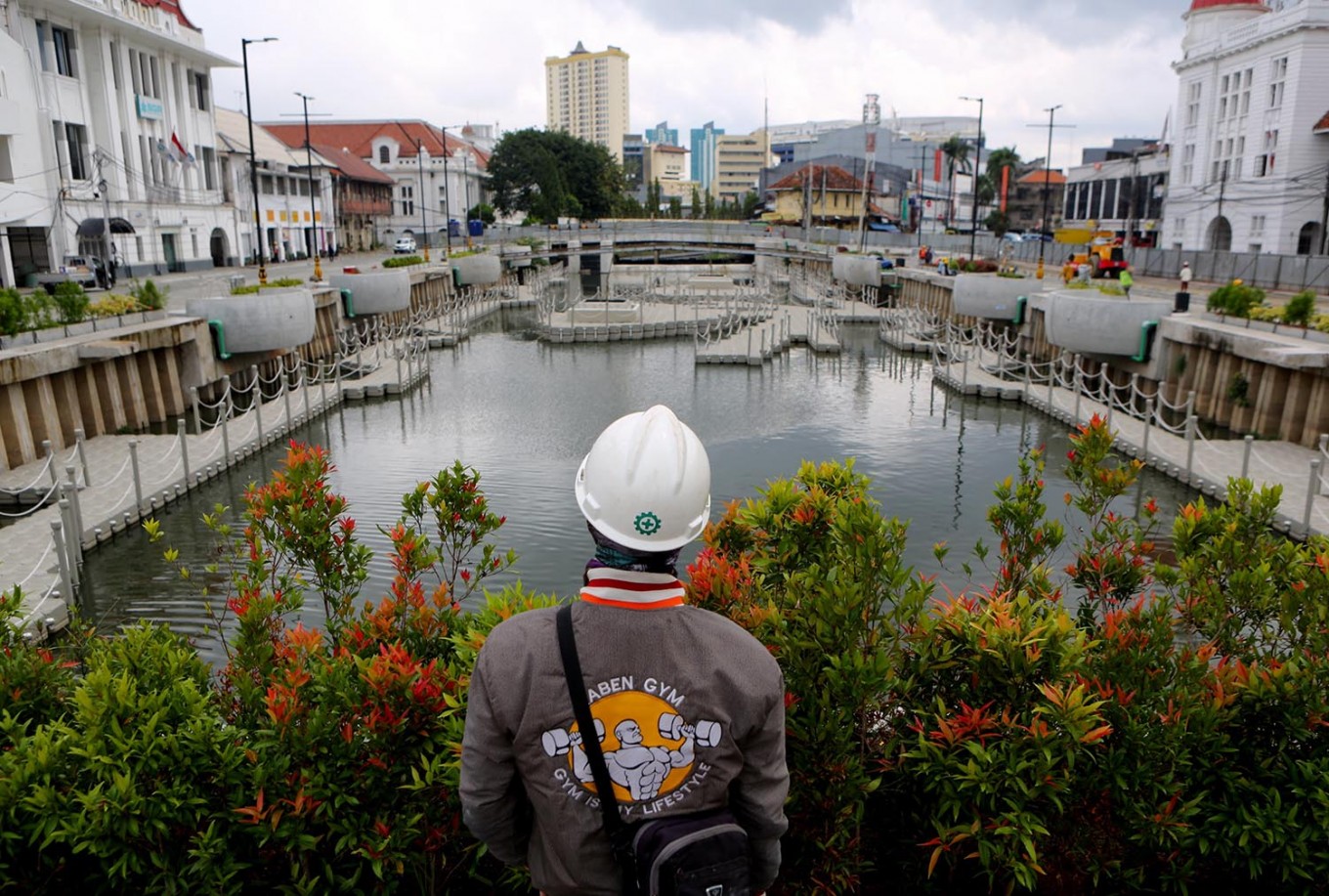491 years old Jakarta: An age for environmental health
Now that Jakarta is turning 491, it's time for the city to take care of its environment.
Change Size
 A worker finishes the revitalization of a watered area in Kota Tua, West Jakarta, Tuesday, Jan. 30. (JP/Seto Wardhana.)
A worker finishes the revitalization of a watered area in Kota Tua, West Jakarta, Tuesday, Jan. 30. (JP/Seto Wardhana.)
A
s with every birthday I wish to plead good health, and every June 22 I also silently pray for Jakarta to get healthier. Relatively young by celebrated age, modern Jakarta has been suffering various symptoms of a sick body and the problem becomes more critical by each passing year. Unfortunately, the very environmental component of Jakarta is bad enough — and it costs us our health.
The air quality, much complained about, is surpassing the World Health Organization's (WHO) guideline for majority of the year with only 25 to 26 of the days throughout 2017 in good quality for everyone, according to the United States Embassy. Since breathing is 24/7, the potential for disease from air pollution is the highest. Earlier last year, medical journal The Lancet Commission had a report on pollution and human health that predicted that 72 percent of premature deaths worldwide are associated with air pollution.
The water is in no better shape — Ciliwung, Jakarta’s biggest river is famous as one of the most polluted rivers globally, for year after year it has not moved from the heavily polluted quality classification, as reported by the Central Statistics Agency (BPS) in 2017. In the sea, toxic soil of Jakarta Bay, a cocktail sediment of various heavy metals and persistent organic pollutants, is now being abruptly stirred up by the infamous reclamation project, bringing in more waste and plastics to the bay.
And with limited land, Jakarta’s waste problem is growing. The city’s landfill is suffering overload with 6,500 tons of Jakartans’ commingled waste every day, frequently driving protests in neighboring municipalities. With every rainy season, the open landfills and unmanaged waste frequently flush into the river, creating waste flood hotspots. There is no data on the city's soil quality, thus the state of the toxic hotspots around Jakarta’s industrial area remains unknown. Ultimately, inseparable from its water pollution problem, Jakarta’s soil has another issue to face: It’s sinking.
Jakarta has its catch-22. Polluted resources lead to more resource extraction, more industrial processes, more energy, more waste and emission, and eventually more cost — either in finance or health or pollution itself. But as the most economically viable city, Jakarta actually has the options to engineer the problem.
A recap of the scale of the problem is an important leverage to have the problem spotted. As advocated by the 2017 Lancet report, despite the many fatalities and burden of disease associated with pollution, it remains a nonpriority. And so is the case of Jakarta.
Prioritizing environmental health is a tricky task, usually very subtle. Programs and budgets aiming to clean up or revitalize polluted areas might be a tiny indicator, but most of the work is to prevent. Without prevention, all money spent to remediate will be washed away as more pollutants pour back into the recently cleaned-up environment. Some preventative tools, stricter environmental regulations and careful assessment of the development plan are necessary, and we must be careful not to add more stress to the polluted environment without reducing existing pollutants.
Jakarta has the authority to create stricter standards than national level — at least for emission and wastewater discharge. For water, Jakarta has got some help from the Environment and Forestry Ministry, whereas Ciliwung River’s load pollution was determined in 2017. The pollution load decree is waiting for a smart follow-up, for example, such as a moratorium of wastewater discharge permit in the heavily polluted segment while reviewing the old permit’s allowable discharge and engineering non-point sources. However, to my knowledge, despite non-point source engineering starting slow with the canal works, no stricter standard is being formulated and no moratorium or permit review program is in place.
The hot potato of coal-fired power plants and incinerator development shows a gap in Jakarta’s strategic environmental assessment (supposedly the basis of the province’s five-year development plan and spatial plan) — and possibly a total absence of the policy’s impact assessment to health and environment in development planning level. An assessment in strategic level is needed to capture the cumulative impact on Jakarta residents and aggregate cost the local government has to incur for dealing with burden of disease associated. Thus, quantitative prediction is needed, allowing cost-benefit analyses and showing the real external cost of a development project. Unfortunately, asking quantitative prediction of burden of disease to policymakers, to date, has resulted in zero answers. Some nongovernmental organization-based studies (i.e. Greenpeace, KPBB) provide the number — mostly in trillions. Since the law provides strategic impact assessment authority to recommend modification, even entire cancellation, of a development plan, it is surely wiser to have a holistic, quantitative consideration of such plan’s externalities.
Prevention also includes better personnel, governance and associated budget to allow development of more reliable inventory and more quality to its decision to permit, to monitor and to enforce. And being the capital of experts and resources, Jakarta actually could do much about it. Upgrading budget for prevention or adding more quality-personnel to its thin line of environmental inspectors is one of the things Jakarta can to before its next birthday — in addition to other ideas advocated in previous paragraphs.
Despite the various legal mandate to provide healthy and sound environment, environmental quality has never been fully implemented anywhere in Indonesia. Jakarta’s history of continuous inhabitation dates back to Tarumanagara days in 5 AD, and the city has carried on so far to date. Seeing from this lens, Jakarta is an old town — mature and wise enough to set good precedents for her younger sisters. And so we wish.
***
Margaretha Quina is an environmental lawyer, head of environmental pollution at the Indonesian Center for Environmental Law (ICEL). She graduated cum laude from the University of Indonesia and got her environmental law specialization as Fulbright Scholar in the Northwestern School of Law, Oregon, USA. She leads the ICEL’s Jurnal Hukum Lingkungan Indonesia and teaches environmental law at Jentera School of Law. Her legal advice sparks the dynamics in Aliansi Zero Waste Indonesia, Indonesian Toxic-free Network, Gerak Bersihkan Udara, Koalisi Melawan Limbah and various cases or policy development that involves pollution.









